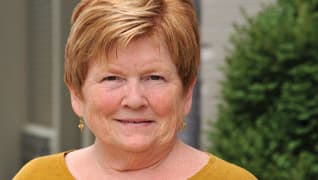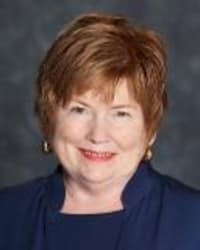The Persistence of Mary Anne Sedey
The St. Louis-based employment litigator speaks on pushing through discovery, her voir dire strategy and giving legal advice to Thurgood Marshall

Published in 2013 Missouri & Kansas Super Lawyers magazine
By Ross Pfund on October 14, 2013
Q: Human Resource Executive magazine named you one of the top 10 plaintiff’s attorneys to fear the most.
A: They did.
Q: Seems like a dubious honor in their eyes.
A: Great honor in mine.
Q: What first got you interested in the law?
A: I’m kind of a child of the ‘60s, and I was very involved in the women’s movement as a young woman, and I wanted work where I could do something about the status of women, and also make a living, and so I was very interested in the law. That brought me into employment law. And I quickly became aware that lots of people besides women had problems on the job, and so that kind of expanded my interest, and I never looked back.
Q: How did you get started?
A: I went to law school in the height of the feminist movement. The year before I went to law school, there were four or five women in the entire class. The year I went, there were 30 of us. So now, it’s half and half. Three of the other women that I went to law school with and I started an all-women’s law firm when we graduated from law school. We went out and we hung up our shingle [as Anderson, Everett, Sedey & Van Amburg in 1975]. There just were not very many women lawyers, and women wanted women lawyers for some of their problems, so that was kind of how we got our start.
Q: I can’t imagine that there were many all-women firms at that time. Did you have to deal with any skepticism?
A: You know what? We got so much encouragement. I remember we went to our law school graduation, and they talked about what we were going to do. They thought it was wonderful. And then we got into practice. We were quite inexperienced, and we relied on other lawyers. Many, many lawyers around town, most all of whom were men just because that’s who was in the profession at the time, were very good to us. They helped us out. They gave us ideas. They shared pleadings. They gave us advice. It was really a wonderful experience.
Q: What does it take to be successful as a plaintiff’s employment lawyer?
A: I think the characteristic that’s most important is persistence. You’re up against big firms; you’re up against big corporations; they say, “No, no, no,” on the discovery. We have to push, push, push.
One of the things I find most enjoyable about the practice is that you mostly have big firms on the other side, and you have a very complex and interesting area of the law, and so it’s very challenging. You have to bring your ‘A’ game all the time. It’s fun to do work that deals with a lot of intellectual challenges, and where you’ve got good lawyers on the other side. I could tell you about some of the negatives of some of the lawyers on the other side, but we’re dealing mostly with very accomplished and competent lawyers, and they don’t give an inch. So you’ve just got to be persistent.
Q: What’s your strategy for communicating with a jury?
A: It’s really important in voir dire to find out about the juror’s personal experience with work because everybody’s worked, and everybody has attitudes about how things ought to be done at work, and what to expect at work. I think it’s also important to talk about all the ways in which your client tried to solve this problem on their own and took responsibility for the problem; and never to present the client as a victim because jurors are not really interested in that notion of victimization anymore. They want to see people stand up for themselves, take care of themselves, and so the whole business [is about] presenting the client as a worthy person who has worked hard to avoid coming to court, and for whom, really, court is a last resort.
Q: What are your most memorable cases?
A: I had a case that I took as a nationwide claim for class action for women who worked at a company for Rent-A-Center. I worked with a lawyer named Jerry Schlichter. He was my co-counsel here in St. Louis. And we filed a nationwide class action, and got the class certified, and settled the case for $47 million, jobs for hundreds of women, promotions for hundreds of women, and basically, a complete overhaul of the human resources function of that company. That was an extraordinary case, and an extraordinarily satisfying case.
And then I’ve had cases for just individuals that were very satisfying. I represented a Muslim guy named Mohamad Alhalabi who was demoted and then fired from a job by the state of Missouri because, basically, his employees didn’t want to work for a Muslim guy.
It was after the time of September 11, and they harassed him, and sent terrible messages, and it was very satisfying to win that case because Mohamad was treated terribly and truly did not deserve it.
Q: Are you seeing the same sorts of discrimination today that you saw when you started your career? How have things changed?
A: Well, I think things tend to come in waves, and so it’s varied over my career. But right now, we’re seeing a lot of age discrimination because I think older employees are losing their jobs in pretty significant numbers again. The other thing we’re seeing is a lot of whistle-blowers. I think, particularly after the economic downturn, employers were less tolerant of employees that wanted to see the letter of the law followed, and so we’re seeing a lot of whistle-blower stuff now.
Q: Tell me about arguing in front of the U.S. Supreme Court.
A: That was an amazing experience. It was in 1987. It was a sex discrimination case. I represented a woman named Cynthia Forrester who had been a juvenile probation officer in a court and worked for Judge Howard Lee White. When the [community’s] high school football coach retired, the judge fired her and hired the retired football coach. The issue before the Supreme Court was whether judges could be sued for sex discrimination.
It was fascinating because if I won, that meant that even a federal judge, even a Supreme Court judge, could be sued for sex discrimination. So we weren’t just talking theoretically about something at that argument. Those judges were talking to me about something that could happen to them, in theory. And we won. I got a unanimous opinion, 8-0, and Sandra Day O’Connor wrote it.
Q: It seems like you might have been at a disadvantage, arguing for a position that would mean that the justices themselves would theoretically put themselves more at risk.
A: Well, I don’t think anybody’s going to sue anybody on the Supreme Court. But having said that, it was still a good argument because I had Thurgood Marshall ask me, “Well, what would happen if I wanted to fire my chauffeur?”
And I said, “Well, you could fire your chauffeur as long as you didn’t decide to do it based on your chauffeur’s sex.” I was kind of surprised when Justice Marshall asked me [that]. I never thought of him as a guy who had a chauffeur, although of course when you think about it, every Supreme Court justice has a driver. My family used to say, “Yeah, Thurgood Marshall asked her for legal advice.” That was pretty thrilling because he was such a hero.
Q: And hopefully his chauffeur didn’t hear about that question.
A: Right! Exactly.
Search attorney feature articles

Featured lawyers

Helpful links
Other featured articles
Jonathan Hollingsworth has an array of firsts, but helping others is what he’s about
What Wonder Woman represents to immigration attorney Heather Poole and her clients
José Feliciano sparks Hispanic empowerment
Find top lawyers with confidence
The Super Lawyers patented selection process is peer influenced and research driven, selecting the top 5% of attorneys to the Super Lawyers lists each year. We know lawyers and make it easy to connect with them.
Find a lawyer near you

